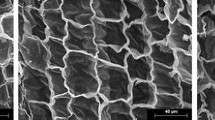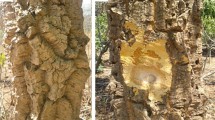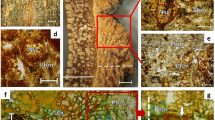Summary
The chemical composition of waxes was studied in cork planks from three different trees of Spanish Quercus suber at four different stages of the in‐dustrial processing of the first transformation: stripping, first rest, boiling fol‐lowed by open air rest and boiling followed by store-room rest. Waxes were extracted with chloroform (CHCl3) and the extract was submitted to saponification in order to obtain the neutral and acid fractions. The trimethylsilyl derivatives of both fractions were analysed by GC-MS. An important decrease of the total content of waxes -CHCl3 extract-(average values: 10.13 to 4.91%) and of the acid fraction (average values: 2.51 to 0.96%) was observed throughout the industrial processing. Some differences were also found among trees, two of them being richer in total waxes (average, 8.14 and 7.71%) than the other one (average, 4.67%). Concerning the three groups of identified components (fatty acids, fatty alcohols and triterpenes), the contents of the fatty alcohols and acids suffer an important reduction during the first rest (average values: 30.39 to 17.53% and 58.73 to 31.48%, respectively), while after boiling, there is a decrease of the triterpenes concentrations (79.16 to 58.00% -neutral fraction- and 40.23 to 23.20% -acid fraction-), being greater when the second rest is carried out in a store room. Significant differences among trees were only found in the fatty alcohols contents. The neutral fraction was mainly composed by fatty alcohols (all the even members from C18 to C26, with traces of intermediate odd members and some unsaturated groups, C20 and C21) and triterpenes (14 components, among them friedelin, betulin and cerin were identified), and a very small amount of monocarboxylic fatty acids (C16, C18, C22 and C24 members) was also present. The main group of components of the acid fraction was that of fatty acids (saturated even C12–C24 and odd C15, C17, C21 members, accompanied by a great amount of unsaturated terms and some ω-hydroxyacids, 18-hydroxy-9,12-octadecadienoic and 18-hydroxy-9-octadecenoic acids). Four triterpenes, the C20, C24 and C28 alcohols and ferulic acid were also detected in the acid fraction. Some of these individual components of each fraction were also affected by the industrial processing and presented significant differences among the studied trees.
Similar content being viewed by others
Author information
Authors and Affiliations
Additional information
Received 12 December 1997
Rights and permissions
About this article
Cite this article
Conde, E., García-Vallejo, M. & Cadahía, E. Waxes composition of reproduction cork from Quercus suber and its variability throughout the industrial processing. Wood Science and Technology 33, 229–244 (1999). https://doi.org/10.1007/s002260050112
Issue Date:
DOI: https://doi.org/10.1007/s002260050112




